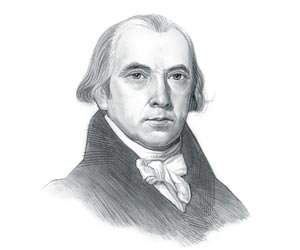|
The major accomplishments and the
famous, main events that occurred during the time that
James Madison was president included the War of
1812, Washington DC was burned (1814) and the Second
Barbary War (1815). During his presidency the Cumberland
Road was constructed and Francis Scott Key wrote the
Star Spangled Banner poem after the British bombardment
of Fort McHenry. James Madison died
of natural causes on June 28, 1836, aged 85. The next president was
James Monroe.
Birthday:
March 16, 1751
Place of Birth:
Virginia
Political Party:
Democratic-Republican
Nickname:
Father of the Bill of Rights
Number: 4th
President
Vice Presidents:
George Clinton & Elbridge Gerry
Age at Inauguration:
57
Height: 5 feet
4 inches
Weight: 100lbs
First Lady:
Dolley Madison
Religion:
Episcopalian
Date of Death:
June 28, 1836
Date of James
Madison
Presidency:
March 4, 1809 to March 4, 1817
The Nickname of James Madison: Father of the Bill of Rights
The nickname of President James Madison provides an insight into how the man
was viewed by the American public during his presidency. The meaning
of the nickname Father of the Bill of Rights refers to his role in
creating the Constitution and as the main auth of the amendments
to the Constitution formed the basis of the Bill of Rights. James
Madison also
had the nicknames of Jemmie or Little Johnny in reference to his
small stature
Character and Personality Type of James Madison
The character traits of President James Madison can be described as shy,
intelligent, meticulous, ponderous and firm. It has been speculated that the Myers-Briggs
personality type for James Madison is an INTP (introversion, intuition,
thinking, perceiving). A modest, reserved, stoic character with a
preference to work informally with others as equals. James Madison
Personality type: Quiet, analytical, impatient and thoughtful.
Accomplishments of James Madison and the Famous Events during his Presidency
The accomplishments of James Madison and the most famous events during his
presidency are provided in an interesting, short summary format
detailed below.
The War of 1812 and the Treaty of Ghent
Summary of the War of 1812: The
War of
1812
(1812-1814), often referred to
as the Second War of Independence,
was fought
between the United States and
Great Britain. The war lasted for 2 years and 8 months and resulted
in a stalemate, but it was a turning point for the US who achieved
credibility across the world as a powerful new nation. The
Treaty
of Ghent ended the War of 1812 and was signed on December 24, 1814.
The Burning of Washington DC
Summary of the Burning of Washington DC: The
Burning of
Washington DC
by the British occurred on August 24, 1814, during the War of 1812,
in retaliation for the sacking of York and as an attempt to
demoralize the American nation. British officers ate dinner at the
White House (then referred to as the Executive Mansion) and the
British set fire to the White House, the Treasury Department
building, the docks and all the public buildings in the capital
including the Library of Congress.
The Star Spangled Banner
Summary of the
Star Spangled Banner: There was a
surge of American Patriotism during the War of 1812 and the
Star Spangled Banner
was written on September 14, 1814 by Francis Scott Lee following the
US victory at the Battle of Baltimore and the Defence of Fort Henry.
The lyrics were written following the US victory at the Battle of
Baltimore, in the War of 1812.
Second Bank of the United States
Summary of the Second Bank of the United States: The
Second Bank
of the United States
was granted a charter in 1816 to manage the massive war debt
amounted during the War of 1812.
The Hartford Convention
Summary of the Hartford Convention: The
Hartford
Convention
was a secret meeting of Federalists in Hartford, Connecticut
to express grievances against the administration of President James
Madison.
The secret convention discredited the
Federalist party as the
outcome of the War of 1812 was rejoiced by the nation and the
Republican party of James Madison gained in popularity with the
voters.
The Second Barbary War
Summary of the Second Barbary War: The
Second Barbary War of 1815 (aka the Algerine War)
ended in victory for the Americans against the African
Pirates of the Barbary States that consisted of Morocco,
Tunis, Tripoli and Algiers.
The Protective Tariff of 1816
Summary of the Protective Tariff of 1816: The
Protective Tariff of 1816
was passed in an attempt to persuade Americans to buy home produced goods
by
placing a 20-25 % tax on all foreign goods. The
tariff was important as it helped American businesses compete with
British and European factories.
Construction of the Cumberland Road
Summary of the Construction of the Cumberland Road: The
Construction
of the Cumberland Road
began in 1811 and ended in 1837 and stretched along
600 miles. It served as a gateway to the West for thousands of
settlers in the Northwest Territory.
History of the Turnpikes and Toll Roads
Summary of the
History of the Turnpikes: The process
of building roads was very expensive and led to the widespread
introduction of Toll Roads, that were called Turnpikes, across the
new nation.
|

